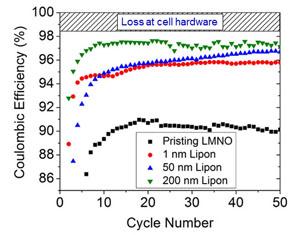
Efficacy of Lipon coating as an artificial SEI for suppression of electrolyte decomposition on a 5V spinel cathode: coulombic efficiency was measured versus cycle numbers at samples with different coating thickness.
An artificial solid electrolyte interphase (SEI) of lithium phosphorus oxynitride (Lipon) enables the use of 5V cathode materials with conventional carbonate electrolytes in lithium-ion batteries. Five volt cathode materials, such as LiNi0.5Mn1.5O4, are desirable to provide higher energy, however conventional carbonate electrolytes decompose above 4.5V compromising the battery performance. This work shows that Lipon coating suppresses the electrolyte decomposition, as measured by the charge-discharge coulombic efficiency. A model system composed of bare and Lipon-coated thin film cathodes was designed with a low capacity in order to magnify the measureable effect of the electrolyte decomposition. The thickness of the Lipon SEI was varied over a range of two orders of magnitude, clearly showing that the largest effect is obtained from the thinnest coatings which are sufficient to block the electronic path of the reaction without impeding lithium ion transport. This research provides a viable approach to enable high-energy batteries within the conventional battery manufacturing processes with the application of a thin coating to cathode powders.
Juchuan Li, Loïc Baggetto, Surendra K. Martha, Gabriel M. Veith, Jagjit Nanda, Chengdu Liang, and Nancy J. Dudney, “An Artificial Solid Electroltye Interphase Enables the Use of a LiNi0.5Mn1.5O4 5V Cathode with Conventional Electrolytes,” Advanced Energy Materials, DOI: 10.1002/aenm201300378
For more information

